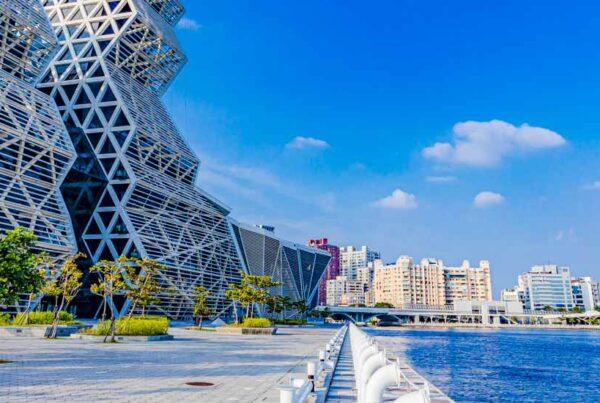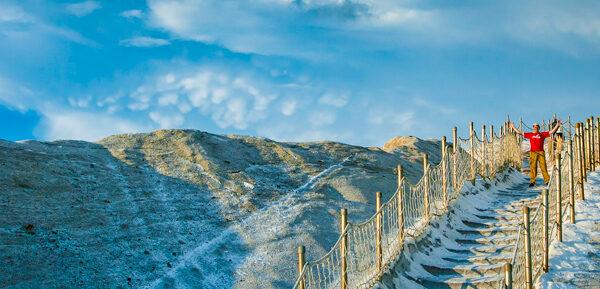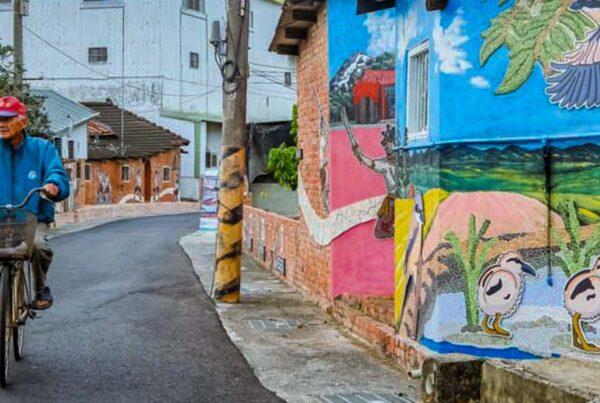Festival Fun and Sightseeing in Rural Tainan Districts
TEXT / STEVEN CROOK
PHOTOS / VISION
Taiwan has a festival culture, and Tainan is a bastion of tradition, so it goes without saying that the region boasts some of the country’s most exciting festivals.
Many of these events, such as deities’ birthday celebrations and the spectacular boat-burning rituals that certain temples hold every three or twelve years, are explicitly religious. Others mark historical events or personal milestones. The Qixi Coming-of-Age Ceremony (Tainan Chihsi Festival), usually held in August, is an example of the latter. It dates back to the early 1700s, when turning 16 meant a dockhand or craft apprentice would begin to receive full adult wages.
Like the Christmastime season in Western nations, the Lunar New Year period is especially joyous in Taiwan. As well as local editions of the Lantern Festival, at this time of year Tainan residents can enjoy the Longci Light Festival, a recent addition to the cultural calendar.
Yuejin Lantern Festival in Yanshui
Running parallel to the 2024 Taiwan Lantern Festival, which this year is being held in Tainan’s Anping District and around the city’s High Speed Rail Station, the Yuejin Lantern Festival is another reason to visit the sublimely characterful town of Yanshui (part of Tainan’s Yanshui District).



Now something of a backwater, Yanshui was one of Taiwan’s most important settlements between the mid-18th and mid-19th centuries. An old Taiwanese idiom expressed this ranking: “First, Tainan; second, Lukang; third, Bangka (the original Taiwanese name for Wanhua in Taipei); fourth, Yuejin (the name of Yanshui’s port).” But when a buildup of silt blocked access to the town’s docks, trade went elsewhere.
At the site of the old river port, nowadays there’s no indication that this spot was once a hive of activity. Yuejin Harbor Riverside Park offers pleasing vistas of placid water and shaded pathways which, during the lantern festival, are being enlivened with creative installations. Another current attraction is the Garden of New Horizons, co-created with members of the public, who were invited to reflect on their relationship with the body of water.
The 2024 Yuejin Lantern Festival kicked off on January 27 and runs until March 3. The lanterns and other displays are lit up from 6pm to 10pm each evening. In addition to seeing the attractions at the riverside park, visitors should walk the 900m to Wu Temple, where a sound-and-light show that recreates Yanshui’s famous Beehive Fireworks Festival can be seen. That raucous event – the 2024 edition takes place February 23-24 – reenacts a 19th-century plague-expulsion rite in which deities are paraded through the town and bombarded with tens of thousands of firecrackers and fireworks.

During festivals in Yanshui, parking can be extremely difficult, so it makes sense to get to the town by bus. Frequent Brown Line buses of the Tainan City Bus network (2384.tainan.gov.tw/newtnbusweb) connect Yanshui with the town of Xinying, where both express and local trains stop.
Yanshui Town
Whether you’ve come to Yanshui for one of the above festivals, or just to enjoy a few hours of sightseeing, a logical place to begin is Qiaonan Old Street. The street’s name means “south of the bridge,” and while the tiny bridge referred to, Xinglong Bridge, isn’t particularly old, more than a dozen of the buildings here are more ancient than the town’s most wizened resident. In Yanshui’s heyday, they housed businesses related to the nearby docks. Several of them are now empty and slowly falling into dilapidation.


Liu Family Abode
The ruins of No. 68 have been turned into a community space. No. 20, also known as the Liu Family Abode, has benefited from a government-funded restoration. Do look inside, as there’s antique furniture and crockery on display, as well as insurance certificates and other documents from the 1895~1945 period of Japanese colonial rule.




Quanli Blacksmith’s Forge
A few doors further along at the northern end of the street, a sixth-generation master craftsman plies his trade at Quanli Blacksmith’s Forge (No. 8). Mr. Li is well past retirement age, but still beats metal into various sharp tools, and proudly says that Japanese visitors are keen buyers of his sashimi knives.


Octagonal Building
About 400m north of Xinglong Bridge on Zhongshan Road, there’s another structure that dates from Yanshui’s most prosperous era, and it’s unlike any other in Taiwan. The Octagonal Building is a unique two-floor building completed in 1847 for a salt-and-sugar tycoon. As was often the case in 19th-century construction projects for the elite, many of the materials and some of the tradesmen were shipped in from mainland China. The first floor is open to the public (8am~5pm daily), but to see upstairs you’ll need to make an appointment. Before you step inside, pay careful attention to the carvings of cranes, flowers, and other auspicious symbols around the central entrance. And note that the family had its own freshwater well – a sure sign of wealth in the Taiwan of yore.




Xiude Worship Pavilion Square
About 50m to the west, a different kind of relic stands in a small park. Xiude Worship Pavilion Square preserves all that remains of the temple that once stood here. This simple yet dignified remnant, you’ll no doubt notice, bears a counterclockwise Buddhist swastika.

Holy Trinity Catholic Church
People don’t come to Taiwan expecting dazzling churches, as fewer than one in ten Taiwanese is Christian. But the Holy Trinity Catholic Church (open Wednesday~Sunday, 10am~11:30am and 1pm~3:30pm) is quite remarkable. Inside, the walls and ceiling are crammed with images. In addition to The Last Supper – in which The Twelve Apostles are attired like the sages of ancient China – and the Stations of the Cross, there are Eye-of-Providence and skull-and-crossbones motifs. It’s almost as if the church’s decorators felt compelled to compete with local temples and create an interior that’s filled to the gills with colors, symbols, and images.




Holy Trinity Catholic Church
(鹽水天主堂)
Add: No. 19, Ximen Rd., Yanshui District, Tainan City
(台南市鹽水區西門路19號) (closed Monday and Tuesday)
Yinfeng Ice Shop
If it’s a warm day or you just want to take the weight off your feet, Yinfeng Ice Shop (open 10:30am~10pm) has an unbeatable location next to the Octagonal Pavilion. This landmark dessert shop, replete with an old-school cyan color scheme, serves a range of sweet treats (NT$30~$50) that combine shaved ice, pudding, and condensed milk. Topping options include adzuki beans, chocolate syrup, and strawberry syrup. To the dismay of some of its regular customers, Yinfeng no longer sells its signature adzuki bean/milk/raw egg combo, because of the salmonella risk.




Yinfeng Ice Shop
(銀鋒冰果室)
Add: No. 1, Zhongshan Rd., Yanshui District, Tainan City
(台南市鹽水區中山路1號)
Tel: (06) 652-2202
Ah-Ji Yi Mian Noodle Shop
A craving for hot food is best answered with a serving of an unpretentious dish that’s come to be associated with Yanshui. Yimian consists of wheat noodles usually served with some pork gravy and bean sprouts, flavored with a little crushed garlic. Portions at Ah-Ji Yi Mian Noodle Shop (open 8am~5pm daily), which is located opposite the Yanshui Sightseeing Delicious Food Hall, tend to be quite small, so consider ordering a side dish or two. It’s unlikely you’ll spend more than NT$100 per person. There are several other food options, including yimian, inside the food hall building as well.

Ah-Ji Yi Mian Noodle Shop
(阿姬意麵)
Add: No. 2-8, Zhongshan Rd., Yanshui District, Tainan City
(台南市鹽水區中山路2-8號)
Tel: (06) 652-5078
Longqi District
The small town of Longqi (part of Longqi District) is set amidst badlands topography, bamboo forests, and pineapple plantations. Since 2019, it’s been the venue for a wintertime cultural extravaganza that makes the most of this charming rural environment, and which last year drew over 100,000 visitors to a district inhabited by fewer than 3,500 people.



The most recent edition of the Longci Light Festival brightened this corner of Tainan from December 23 to February 18, both serving as a grand finale for 2023 and getting the ball rolling for this year’s Tainan 400th anniversary celebrations. The opening ceremony included a performance by PiLi International Multimedia, a hand-puppetry (budaixi) troupe. PiLi’s martial-arts fantasies, broadcast on TV and streamed over the Internet, have won it a worldwide following.
Working within the theme “Void Mountain: Embers of Dragonfire,” 15 teams of artists unveiled 17 wonderful works at the principal venue, Huxingshan Park. This series of animations, installations, multimedia works, and immersive experiences invited audiences to become participants rather than mere spectators, and to savor a thrilling after-dark, outdoors world of creativity and imagination. For a community that has lost well over half its population since the 1970s, the idea of “rekindling embers” – encouraging people to think about potential resurgence – surely has a strong appeal.
Related activities included bamboo-weaving and candle-making workshops, a local food/slow food promotion, and appreciation of the night skies in conjunction with the Tainan Astronomical Education Area.
Readers planning trips to Taiwan should know that the festival’s pricing policy and traffic controls are standard practice at events expected to draw big crowds. Admission to the Longci Light Festival costs NT$50 on weekdays, but NT$100 on weekends. Outsiders are not allowed to bring their cars near the venue on weekends and holidays. Instead, they have to park outside the town and board a shuttle bus. Budget-conscious travelers will save some money if they visit popular attractions mid-week, while self-driving visitors will get the most out of their vehicles if they pay attention to traffic-restriction announcements.
Guanmiao District
Like Xinhua (taiwaneverything.cc/2024/01/23/tainan), Guanmiao town (part of Guanmiao District, which borders Longqi District) has for most of its history been a place where farmers come to sell crops and stock up on essentials. In recent years, its most famous products have been pineapples and noodles.
Many of the former are exported to Japan. While pineapple cakes can be found in every corner of Taiwan, in Guanmiao you’ll see diverse other products that make good use of the fruit. In addition to dried pineapple (an excellent snack to carry when hiking), local businesses make pineapple-flavored popsicles, breads, and baby snacks.


Guanmiao-style noodles are made without salt, then air-dried prior to packing. Except when the weather is bad, at the Ta Cheng Ma Noodle factory – which has an on-site shop – you’ll see scores of flat wicker basins, each holding 20 or more servings of noodles, soaking up the warm southern sun.

If you’re passing through Guanmiao, bound perhaps for Longqi, there are a couple of other sights worth detouring for. The first is Shanxi Temple, close to the town’s morning market. When cracks appeared in a stairway inside this lively place of worship, the faithful immediately declared them to be a sign from the temple’s patron deity, Guan Gong, because they resembled the polearm-type weapon that this god is often depicted as holding.

The other is Datanpiwanglai Park, very close to Ta Cheng Ma Noodle on the eastern edge of town. The park’s twin mini-lakes were created in the 18th century by Han pioneers who needed a reliable water supply for agriculture. For local people, it’s a popular place to go jogging or play badminton. For tourists, it’s a good spot to have a picnic with some of those pineapple-based treats. Just the thing if frantic sightseeing has left you a bit depleted.

About the author

Steven Crook
Steven Crook, who grew up in England, first arrived in Taiwan in 1991. Since 1996, he’s been writing about Taiwan’s natural and cultural attractions for newspapers and magazines, including CNN Traveler Asia-Pacific, Christian Science Monitor, and various inflight magazines. He’s the author of four books about the country: Keeping Up With The War God (2001), Dos And Don’ts In Taiwan (2010), Taiwan: The Bradt Travel Guide (2010), and A Culinary History of Taipei: Beyond Pork and Ponlai (2018)
http://crooksteven.blogspot.com
http://bradttaiwan.blogspot.com



















